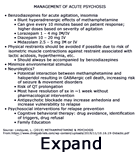Methamphetamine
Associated Psychosis (MAP)
The World Health Organization's International Classification of Diseases (ICD-11) code 6C46.6
Stimulant-induced psychotic disorder including amphetamines, methamphetamine and methcathinone is characterised by psychotic symptoms (e.g., delusions, hallucinations, disorganised thinking, grossly disorganised behaviour) that develop during or soon after intoxication or withdrawal due to stimulants. The intensity or duration of the symptoms is substantially in excess of psychotic-like disturbances of perception, cognition, or behaviour that are characteristic of Stimulant intoxication or Stimulant withdrawal. The amount and duration of stimulant use must be capable of producing psychotic symptoms. The symptoms are not better explained by a primary mental disorder (e.g., Schizophrenia, a Mood disorder with psychotic symptoms), as might be the case if the psychotic symptoms preceded the onset of the stimulant use, if the symptoms persist for a substantial period of time after cessation of the stimulant use or withdrawal, or if there is other evidence of a pre-existing primary mental disorder with psychotic symptoms (e.g., a history of prior episodes not associated with use of stimulants).
Some common delusions:
Delusions of Persecution - The person feels threatened and believes that others intend to harm him in some way. For example: the individual thinks that the CIA intends to kill him.
Delusions of Grandeur - The individual has an exaggerated feeling of importance, power or knowledge. Example: The person thinks that he is in control of the state.
Delusions of Reference - The person thinks that unrelated events or happenings are somehow connected to them, usually negatively. Example: the user watching TV thinks the news broadcaster is trying to get a message to him.
Delusions of being controlled - the person believes certain objects or persons have control over his/her behavior. For example: the individual believes that the president of the United States has control over his behavior.
Somatic Delusions - The individual believes that his/her body or parts of the body are changing or being distorted. For example: the person believes his brain is rotting. |
Stimulant-induced psychotic disorder with hallucinations is characterised by the presence of hallucinations that are judged to be the direct consequence of stimulant use. Neither delusions nor other psychotic symptoms are present. The symptoms do not occur exclusively during hypnogogic or hypnopompic states, are not better accounted for by another mental and behavioural disorder (e.g., schizophrenia), and are not due to another disorder or disease classified elsewhere (e.g., epilepsies with visual symptoms).
Stimulant-induced psychotic delusions of events, objects, or other people in the person's immediate environment have a particular and unusual personal significance, usually of a negative or pejorative nature. The delusions are variable in content across individuals, but typically stable within individuals, although they may evolve over time.
Other symptoms of clear and persistent hallucinations, negative symptoms, disorganised thinking, or experiences of influence, passivity, or control are not present, although various forms of perceptual disturbances (e.g. hallucinations, illusions, misidentifications of persons) thematically related to the delusion are still consistent with the diagnosis. Apart from actions and attitudes directly related to the delusion or delusional system, affect, speech, and behavior are typically unaffected.
Medical Management of Methamphetamine
Psychosis:
 The MAP patient presents a potential risk of injury to him/herself and to the healthcare staff. MAP patients may be agitated, aggressive and highly suspicious. When this is the case, the safety of the patient and those in the vicinity is primary.
The MAP patient presents a potential risk of injury to him/herself and to the healthcare staff. MAP patients may be agitated, aggressive and highly suspicious. When this is the case, the safety of the patient and those in the vicinity is primary.
McKetin et al (2014) reported that they found:
- a dose-related increase in violent behaviour when an individual was using methamphetamine compared with when they were not after adjusting for other substance use and socio-demographics.
- The odds of violent behaviour were further increased by psychotic symptoms (OR = 2.0, 95% CI = 1.1–3.6), which accounted for 22–30% of violent behaviour related to methamphetamine use.
- Heavy alcohol consumption also increased the risk of violent behaviour (OR = 3.1, 95% CI = 1.4–7.0) and accounted for 12–18% of the violence risk related to methamphetamine use
A sense of safety and reassurance is necessary to develop every therapeutic relationship. Early involvement by a skilled psychiatric clinician may defuse tension and facilitate pharmacologic treatment.
Reference:
Lindquist, L. (2019). METHAMPHETAMINE & PSYCHOSIS.
From: https://www.chistgabriels.com/wp-content/uploads/2019/11/10.16.19-Didactic.pdf
McKetin, R., Lubman, D. I., Najman, J. M., Dawe, S., Butterworth, P., & Baker, A. L. (2014). Does methamphetamine use increase violent behaviour? evidence from a prospective longitudinal study. Addiction, 109(5), 798–806. https://doi.org/10.1111/add.12474
World Health Organization. (2022). ICD-11: International classification of diseases and related health problems (11th revision). https://icd.who.int/browse11/l-m/en
©RnCeus.com
 The MAP patient presents a potential risk of injury to him/herself and to the healthcare staff. MAP patients may be agitated, aggressive and highly suspicious. When this is the case, the safety of the patient and those in the vicinity is primary.
The MAP patient presents a potential risk of injury to him/herself and to the healthcare staff. MAP patients may be agitated, aggressive and highly suspicious. When this is the case, the safety of the patient and those in the vicinity is primary.